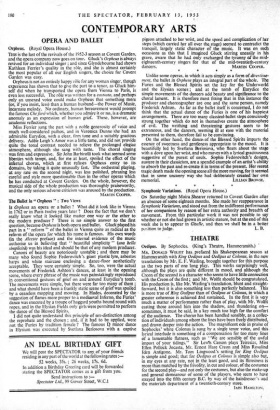Unlike some operas, in which it acts simply as a
form of divertisse- ment, the ballet in Orpheus plays an integral part of the whole. The Furies and the Blessed Spirits set the key for the Underworld - and the Elysian scenes and at the tomb of Eurydice the simple movements of the dancers add beauty and significance to the choral lament. It is therefore most fitting that in this instance the producer and choreographer are one and the same person, namely Frederick Ashton. As far as the ballet itself is concerned, I do- not think that the actual dance of the Furies is one of his happiest arrangements. There are too many classical-ballet steps consciously strung together which do not in themselves create the atmosphere of evil. The writhing and threatening gestures seem to be extraneous, and the dancers, seeming ill at ease with the material presented to them, therefore fail to be convincing.
On the other hand, the dance.of the Blessed Spirits imparts the essence of sweetness and gentleness appropriate to the mood. It is beautifully led by Svetlana Berioiova, who floats about the stage with a dove upon her wrist, and who moves with a lyrical graciousness suggestive of the purest of souls. Sophie Fedorovitch's designs, austere in their classicism, are a spendid example of an artist's ability to absorb the past and re-create it in terms of the present. Her recent tragic death made the opening scene all the mortmoving for it seemed that in some uncanny way she had deliberately created -her own


































 Previous page
Previous page